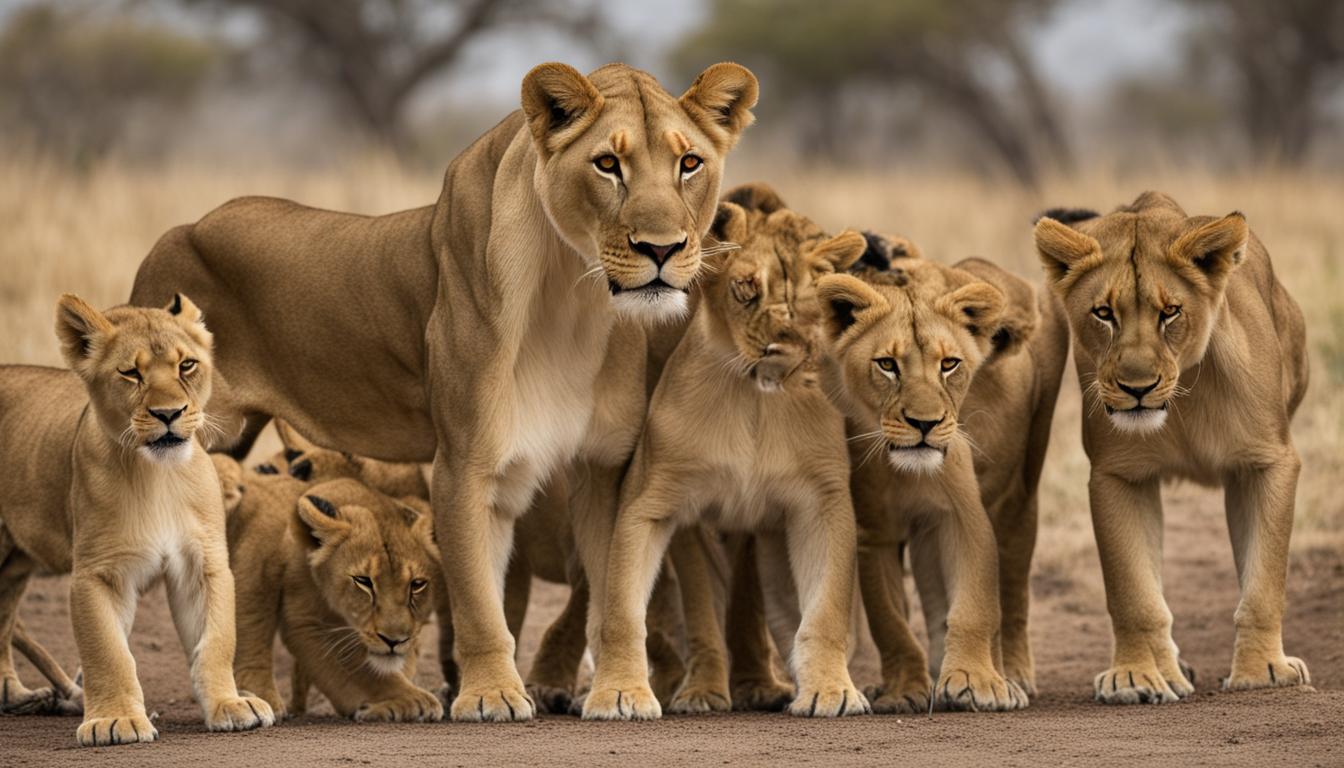Lions have a complex social structure that is centered around prides. A pride usually consists of five or six females, along with their cubs, and may have one or two dominant males. The dominant male in the pride has the exclusive right to mate with the females. The members of the pride work together to protect each other and their young from other predators. Within the pride, there is often a hierarchical order that determines the dominant individuals during fights. Lions also lead a nomadic lifestyle, and changes in dynamics occur when females are expelled from the pride or when males challenge the dominant male.
Key Takeaways:
- Lions have a complex social structure centered around prides.
- A pride typically consists of 5-6 females and their cubs.
- One or two dominant males have the right to mate with the females.
- Members of the pride work together to protect each other and their young.
- There is a hierarchy within the pride that determines dominance during fights.
The Formation of Lion Coalitions
Male lions play a crucial role in the social dynamics of a lion pride. When they reach sexual maturity at around 18-24 months, male lions typically disperse from their natal pride. This dispersal can occur individually or in the formation of coalitions with other related males. These coalitions serve various purposes, including protection and increasing chances of successful reproduction. Within a lion coalition, there is a dominance hierarchy that determines the interactions between the males and with the females in the pride.
To establish dominance within a coalition, lions engage in various behaviors such as posturing and vocalizations. These displays of dominance help determine the pecking order within the coalition, with one male being dominant over the others. The dominant male typically has priority access to mating opportunities with the females in the pride. This male-female interaction is influenced by the dominance hierarchy, with subordinate males potentially facing challenges in reproducing.
Understanding the organization of lion coalitions provides valuable insights into the social behavior of these majestic creatures. By forming coalitions, male lions can increase their chances of survival and reproduction while contributing to the stability and protection of the pride. This cooperation and social organization play a vital role in the overall functioning of lion societies.
The Formation of Lion Coalitions
| Advantages of Lion Coalitions | Challenges of Lion Coalitions |
|---|---|
| Increased protection of the pride | Competition for dominance within the coalition |
| Improved hunting success | Sharing limited resources |
| Enhanced defense against intruders | Coordinating cooperative behavior |
Lion Pride Dynamics and Social Behavior
In the intricate social structure of lion prides, the family dynamic is at the core of their social order. Prides consist of related females and their cubs, who work together to care for and protect the young ones. The bond between the females is so strong that lactating mothers will even suckle cubs that are not their own. Cubs stay with their mother for an extended period of 21-24 months, sometimes up to 30 months, as they learn essential survival skills.
Pride sizes can vary, with smaller prides having around 13 members and larger prides reaching up to 40. Females significantly outnumber the males in a pride, as males tend to have a nomadic lifestyle. They venture out to take on more dangerous game, increasing the risk of being killed during pride takeover attempts. Interestingly, the presence of other lions within a pride’s territory does not guarantee membership. Many lions are transient or “squatters,” and true membership can only be established through a friendly greeting ceremony between members.
While lions actively defend their territory against lions of the same gender, most encounters do not result in physical fights. The social dynamics within a pride are more complex than territorial disputes, emphasizing cooperation and shared protection. Lions rely on their group dynamics to ensure the survival of their pride, working together to hunt, raise cubs, and defend against other predators.
Do Tigers and Lions Have Similar Social Structures Amongst Other Predators?
Tigers’ coexistence with other habitat predators is an intriguing aspect of their social structures. Unlike lions, tigers are solitary beings, preferring to hunt alone and maintain a vast territory. However, when it comes to sharing their habitat with fellow predators, tigers display remarkable adaptability. While conflicts may arise over food and space, tigers have been observed to establish a certain level of tolerance, allowing them to coexist with other predators such as leopards or wild dogs. This unique aspect of their social behavior sets tigers apart from many other predators in the animal kingdom.
FAQ
How do lions interact within their social hierarchy?
Lions have a complex social structure that revolves around prides. A pride typically consists of five or six females along with their cubs, and may have one or two dominant males. The dominant male has the right to mate with the females. The pride members work together to protect each other and their young from other predators. There is often a hierarchy within the pride, determining the dominant individuals during fights. Lions also have a nomadic existence, and changes in dynamics occur when females are run off from the pride or when males challenge the dominant male.
What is the formation of lion coalitions?
Male lions typically disperse from their natal pride when they reach sexual maturity at around 18-24 months. They may disperse on their own or form coalitions with other related males. These coalitions may protect a pride together, with one male being dominant over the others. The lion coalition’s social hierarchy determines their interactions with each other and with the females in the pride. Dominance behaviors, such as posturing and vocalizations, play a role in establishing the pecking order within the coalition. The interaction between the males and females in a pride is also influenced by the dominance hierarchy.
What are lion pride dynamics and social behavior?
Lion prides consist of related females and their cubs. The females work together to care for and protect the cubs, with lactating females suckling cubs indiscriminately. Cubs remain with their mother for 21-24 months up to 30 months. The size of a pride can range from smaller ones with around 13 members to larger prides with up to 40 members. The females outnumber the males in a pride, and males tend to be nomadic, taking on more dangerous game and being killed in pride takeover attempts. The presence within a pride’s territory is not a sign of membership, as many lions are transient or “squatters”. Membership can only be distinguished through a friendly greeting ceremony between pride members. Lions will defend their territory against lions of the same gender, but most encounters do not result in fighting.










